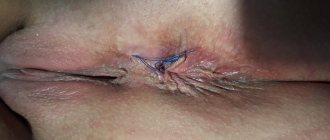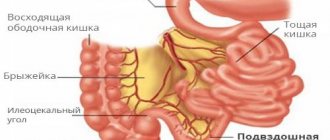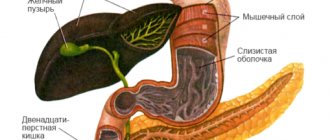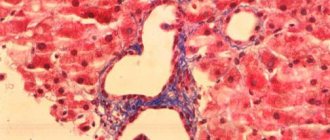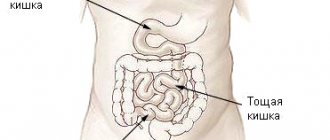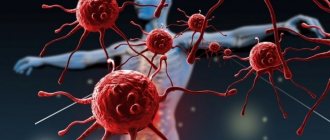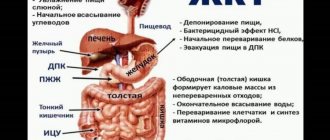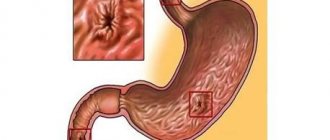Etiology of cryptitis
Normally, intestinal contents often end up in Morgani's crypts. Moreover, this usually does not cause problems, since it empties quite well. The secretion produced by the anal glands does not allow microbial contents to penetrate into deeper layers. Cryptitis develops when normal drainage is disrupted. The cause may be trauma to the mouth of the crypt with hard feces, an inflammatory process in the anal canal (for example, chronic inflammation with anal fissure). Solid impurities in feces (bones, seed shells) can mechanically injure the crypt. Other causes of cryptitis include swelling of the mucous membrane during diarrhea, congestion of cavernous bodies during hemorrhoids, and various types of dermatitis.
If the function of the anal glands is impaired, the outflow from them is impaired, the developed inflammation can spread to deeper layers. Inflammation of the subcutaneous tissue leads to paraproctitis (in fact, this is the main cause of paraproctitis - 87% of cases).
The main signs of cryptitis
1. Pain in the anus during defecation, with “scratching” characteristic. 2. Discomfort in the anus outside of defecation. 3. Quite often, an inflamed crypt is the root cause of constant itching. 4. Peeling during bowel movements. And although this is a nonspecific symptom, which most often indicates the presence of hemorrhoids, it is also often observed with inflammation of the Morganian crypt. 5. Cryptitis is characterized by a wave-like course, so patients talk about previous symptoms with periods of “recovery”.
Features of the structure of the Morganium crypt
The lower part of the rectum is equipped with submucosal folds that form the anal columns. The number of pillars is individual for each person and ranges from 6 to 12. In their lower part, the pillars expand somewhat. The pillars are connected to each other in the lower part by semilunar flaps, forming sinuses similar to pockets, open against the movement of feces. At the bottom of the pocket is the exit of a gland that secretes mucus. The fecal lump, falling into the pocket, is enveloped in mucus. Then the lump, moistened and softened by mucus, slips out of the crypt and joins the feces, softening their passage in the final section of the intestine during defecation.
If the secretion of mucus is disturbed, then an insufficient amount of it poorly wets the fecal lump; it is not completely removed from the crypt. A piece of feces remains in the pocket and completely or partially blocks the exit from it, disrupting normal secretion, causing stagnation of mucus, irritation and subsequent inflammation of the Morganian crypt. Foreign objects in feces, for example, seed husks and coarse fibers, can injure the crypt. Straining and chronic diarrhea, which cause severe irritation of the intestinal mucosa, leading to swelling of the mucous membrane of the rectum and crypt, are dangerous for the crypts.
Complications of cryptitis
Well, in general, cryptitis is something other than an abscess (abscess), which independently opens and drains into the lumen of the rectum. If drainage does not occur, the inflammatory process can affect neighboring crypts, leading to purulent proctitis. But most often the inflammation spreads to the subcutaneous fatty tissue of the ischiorectal region. Then we are talking about acute paraproctitis. If the crypt abscess nevertheless opens into the intestinal lumen, but the outflow is insufficient, then the inflammation takes a chronic form. In this case, they speak of an internal incomplete fistula. The clinic here will have periods of exacerbation and remission. With such chronicity of the inflammatory process, cicatricial deformation of the morganium crypt develops, and dense scar tissue is formed - pectenosis. Severe pectenosis can disrupt the function of rectal emptying, but this happens very rarely.
Kryptit
Cryptitis is an inflammation of the Morganian crypt.
Morganian crypts are depressions in the anal canal. They are a continuation of the so-called. Morganian sinuses, which are located between the Morganian columns. The Morganian crypts in their upper part communicate freely with the lumen of the rectum. The bottom of these crypts is covered with semilunar valves. The ducts of the anal glands open into the Morgani crypts. When the lumen of these glands is blocked, the outflow of secretions from them is poor, or the crypts are injured, an inflammatory process occurs - cryptitis develops.
Causes of cryptitis
Typically, intestinal contents can normally enter Morgani's crypts. However, this does not affect her condition in any way, since she empties well, and the secretion of the anal glands does not allow microbial contents to penetrate into deeper layers. But sometimes this normal process can be disrupted. The reason for this is usually traumatization of the walls of the Morganian crypt with solid feces or impurities to them (for example, seeds, seed husks, pieces of bran, etc.).
Another reason for impaired emptying of the crypts can be caused by their blockage due to the ingress of hard lumps of feces, swelling of the mucous membrane during diarrhea.
Finally, another cause of cryptitis may be blockage (obstruction) of the ducts of the anal glands, which open into these crypts.
So, the cause of the inflammatory process in the crypt can be any violation of rectal emptying (prolonged constipation), or any minimal trauma to the rectum. If the function of the anal glands is disrupted, for example, their lumen is blocked, inflammation can spread to the deeper layers of the rectal wall, which is the cause of paraproctitis.
Manifestations of cryptite
The main signs of cryptitis are:
- Pain in the anus, which becomes pronounced during defecation,
- Feeling of discomfort
- In some cases, there may be a burning sensation or a foreign body sensation in the rectum.
- Often a manifestation of cryptitis can be an admixture of blood in the stool.
- When purulent inflammation occurs in the anus, itching may be felt.
There are usually no other signs of inflammation, such as swelling of the body.
Restoring the normal outflow of secretions from the crypt and anal glands in the acute period of the disease leads to recovery. Sometimes the inflammation process can spread to neighboring crypts and adjacent parts of the rectum. Usually, the inflammatory process during cryptitis occurs in waves: inflammation in the crypt may subside, but under unfavorable conditions everything repeats itself again.
Complications of cryptitis
Usually cryptitis, which is nothing more than an abscess (crypt-abscess), opens on its own into the lumen of the rectum. If this does not happen, the inflammation process spreads to neighboring crypts, which can develop into purulent proctitis - inflammation of the rectal wall. However, most often such purulent cryptitis is complicated by the passage of infection deep into the wall of the rectum with access to the tissue that surrounds it, which is acute paraproctitis.
If the abscess in the crypt still empties into the intestinal lumen, but the outflow from it is still insufficient, or the factors that led to the occurrence of cryptitis, such as constipation, microtrauma after prolonged straining, anal fissures, large hemorrhoids that disrupt the outflow from the crypts and etc., inflammation in the crypt becomes chronic, with periodic exacerbations.
As a result, cicatricial deformation of the Morganian crypt itself occurs, which leads to the formation of an incomplete internal rectal fistula. In some cases, when the inflammatory process becomes chronic in the upper third of the anal canal, where the bottom of the crypt is, dense scar tissue is formed - the so-called. pectenosis
Severe pectenosis, in the case when the scar occupies more than a quarter of the circumference of the anal canal, the elasticity of its tissues and extensibility are reduced, and this, in turn, leads to impaired emptying of the rectum.
Diagnosis of cryptitis
- First, the doctor finds out all the complaints that the patient has, then his general condition is assessed.
- After this, an external examination of the perineal area, perianal area and a thorough digital rectal examination begins, during which the condition of the anal canal is assessed.
- Then anoscopy and sigmoidoscopy are performed.
- If necessary, rectal ultrasound, proctography and biopsy are performed (if a tumor process is suspected).
When only the crypt is involved in the process, no changes are usually noted during external examination of the anus. A digital rectal examination in the upper third of the anal canal and palpation in the area of the crypt itself reveals pain and swelling.
When examined through an anoscope, you can sometimes notice swelling and hyperemia (redness) in the area of the crypt, fibrin deposition, and when pressing on the crypt, pus can be released from it. However, unfortunately, with these types of research it is not always possible to see the bottom of the crypt itself.
Using sigmoidoscopy, the doctor can assess the condition of the mucous membrane of the rectum and the closest one - the distal sigmoid colon, and therefore exclude possible other causes of pain and discharge from the anus.
Differential diagnosis
The acute period and exacerbation of cryptitis should first of all be distinguished from acute paraproctitis - purulent inflammation of the tissue around the rectum.
During a digital examination, palpation of the wall of the anal canal at the level of the crypt between two fingers (the index finger inserted into the anal canal and the thumb on the skin side); the presence of tissue compaction deeper than the crypt itself indicates the presence of paraproctitis.
If there is purulent discharge from the anus in the form of a drop, this more indicates the presence of an incomplete internal fistula of the rectum.
Treatment of cryptitis
Treatment of cryptitis can be either conservative or surgical. Uncomplicated cryptitis is usually treated conservatively.
Diet plays an important role here: you should exclude everything salty, spicy, as well as alcohol. The diet must be in adequate volume to prevent stool retention.
Laxatives should not be used.
For constipation, it is best to use a cleansing enema. This is due to the fact that laxatives lead to liquefaction of feces, and this, in turn, leads to a multi-stage act of defecation, which contributes to irritation and swelling of the rectal mucosa.
Hygiene measures should be carefully observed. Warm sitz baths with a slightly pink solution of potassium permanganate are recommended for 15 to 20 minutes. Be sure to wash the anus area after each act of defecation.
At night for a week, microenemas are administered in a volume of 30 - 40 ml with a 0.3% solution of collargol.
If conservative treatment of cryptitis is ineffective, complications such as acute paraproctitis or incomplete rectal fistula may develop.
In these cases, surgical treatment is indicated, which consists of opening the crypt abscess so that its contents are emptied into the lumen of the rectum, and not into the tissue around it.
Diagnosis of cryptitis
First, the coloproctologist clarifies the patient’s complaints, after which an examination of the perianal area is carried out with a digital rectal examination.
After preparation (cleansing the intestines), anoscopy (or sigmoidoscopy) is performed. In an acute process with inflammation of only one crypt, digital examination gives only local pain. Anoscopy reveals hyperemia and swelling of part of the semicircle of the anal canal. Sometimes, when you press on the crypt, you can detect a drop of pus. With a recurrent process and the formation of scar tissue, a dense ball the size of a grain of wheat can be palpated.
Diagnostics, photo
The examination of the distal rectum includes a mandatory digital examination with a thorough examination of the condition of each crypt. It is first necessary to exclude intermuscular paraproctitis, as well as incomplete intestinal fistula. To do this, carefully examine all painful areas, areas of edema, and suppuration. The wall of the anal canal is examined: the index finger is inserted into the anus, and the thumb is placed on the outside (on the skin). A drop of pus released from the anus may indicate an incomplete fistula of the rectum, and tissue infiltration beyond the crypt indicates paraproctitis.
Cryptitis can also be suspected if palpation in the upper part of the anal canal and crypt reveals a decrease in elasticity and local tissue soreness. Diagnostic procedures are required:
- anoscopy - using a rectal speculum (anoscope), swelling and redness of the crypt are detected, sometimes suppuration is detected in the crypt area;
- sigmoidoscopy - allows you to generally assess the condition of the rectum and the adjacent area of the sigmoid colon.
- ultrasound examination of the perineum.
The scope of necessary research can be supplemented by a biopsy if malignant tissue degeneration is suspected, proctography, which allows using X-rays to study the features of the defecation process, determine the nature of constipation, and the degree of fecal incontinence.
Treatment of cryptitis
Therapeutic measures can be either conservative or surgical. It is very important to normalize your diet: exclude salty, spicy, fried, alcohol. Nutrition must be adequate to prevent stool retention. For constipation, laxatives should not be used. It is best to use a cleansing enema. The fact is that loose stools lead to multiple bowel movements (often in small portions) and irritate the rectal mucosa. Particular attention must be paid to hygiene. After defecation, wet hygiene and sitz baths with chamomile infusion are recommended. At night, microenemas with a 0.3% solution of collargol are recommended. Surgical treatment of cryptitis consists of opening the crypt abscess to drain the purulent focus into the intestinal cavity. Complications of cryptitis: paraproctitis and internal incomplete fistula, also require surgical treatment.
If you find a typo in the text, please let me know. Select a piece of text and press Ctrl+Enter.
Tags: cryptite
« Previous entry
